TTE_Model
Browsable image of the model.
- For an executable version,
- Mouse over the icons to view parameters. Click on hierarchy and plotters to reveal content (if provided).
- To simulate, click on Launch button, open downloaded file and click Run on the Java Security Page.
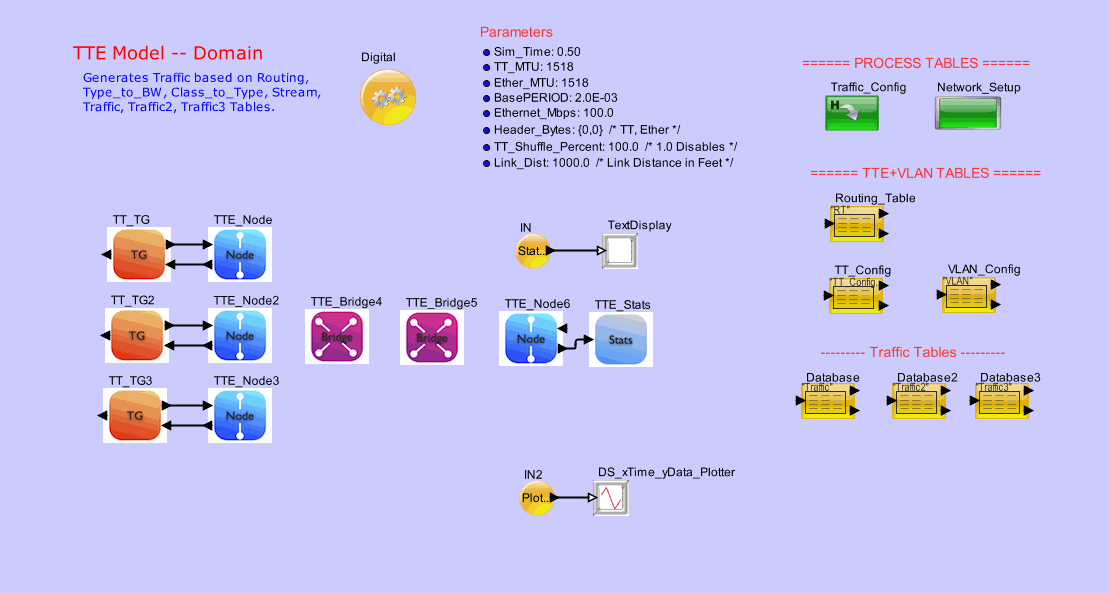
Introduction
TTEthernet has been designed for safe and highly available real-time applications, cyber-physical systems and unified networking. This technology offers deterministic real-time communication and TCP/IP Ethernet traffic in parallel on the same network. TTEthernet simplifies the design of fault-tolerant and high availability solutions. Its innovative technology consolidates experiences and proven mechanisms from aerospace system design, automotive electronics and industrial automation.
Three message types are provided:
- Time-Triggered - Messages are sent over the network at predefined times and take precedence over all other message types. The occurrence, temporal delay and precision of time-triggered messages are predefined and guaranteed. The messages have as little delay on the network as possible and their temporal precision is as accurate as necessary. However, "synchronized local clocks are the fundamental prerequisite for time-triggered communication".
- Rate-Constrained – Messages are used for applications with less stringent determinism and real-time requirements. These messages guarantee that bandwidth is predefined for each application and delays and temporal deviations have defined limits.
- Best-Effort – Messages follow the usual Ethernet policy. There is no guarantee whether and when these messages can be transmitted, what delays occur and if messages arrive at the recipient. Best-effort messages use the remaining bandwidth of the network and have lower priority than the other two types.
About VisualSim TTEthernet Library
VisualSim TTEthernet library can be used to design a completely new TTEthernet based system or integrate with a system in which multiple different protocols are existing.
Below is a brief explanation on each TTEthernet library blocks
2.TTE_Traffic_Gen: This is a traffic generator and it can generate traffic messages with Time-Triggered, Rate Constrained and Best Effort (Normal Ethernet traffic).
3.TTE_Bridge: This block connects to both Nodes and other Bridges. It handles the routing, multicast, compression synchronization and broadcast of clock synchronization messages to all the links.
4.TTE_Setup: One instance of this is required in all TTEthernet models. This processes all the tables in the model.
5.TTE_Stats: This is a convenient block that displays the latency plot for all streams form all the Nodes, writes the information and warning messages to a file in the model directory, and computes the latency jitters and writes it to a separate file in the Model Directory
6.TTE_Config_Table: This is a block that contains the sample of all configuration tables required for TTEthernet.
Tutorial System
Multiple demonstration systems are provided with documentation to guide a user to learn the TTEthernet modeling environment and create executable models.
A demonstration system is provided with explanation on the use of this library. The block diagram is provided below:

The VisualSim model of this design is at VS_AR/demo/networking/TTEthernet/TTE_Simple_Example.xml
Each node consists of one traffic generator which can generate messages of TT, RC and Ethernet; and a node block. The bridge uses the TTE_Bridge block. As Node_5 is a client, we have connected TTE_Stats to it to generate network statistics and stream latency. The TTE_Config_Table and TTE_Setup blocks are added to this block diagram editor to define network attributes. Users have to define few top level model parameters and are given below
Link_Dist = 1000.0 /* Link Distance in Feet, user can modify this */
BasePeriod = 2.0e-3
Header_Bytes={0,0}
TT_Shuffle_Percent = 100.0
Ethernet_MTU=1518
TT_MTU=1518
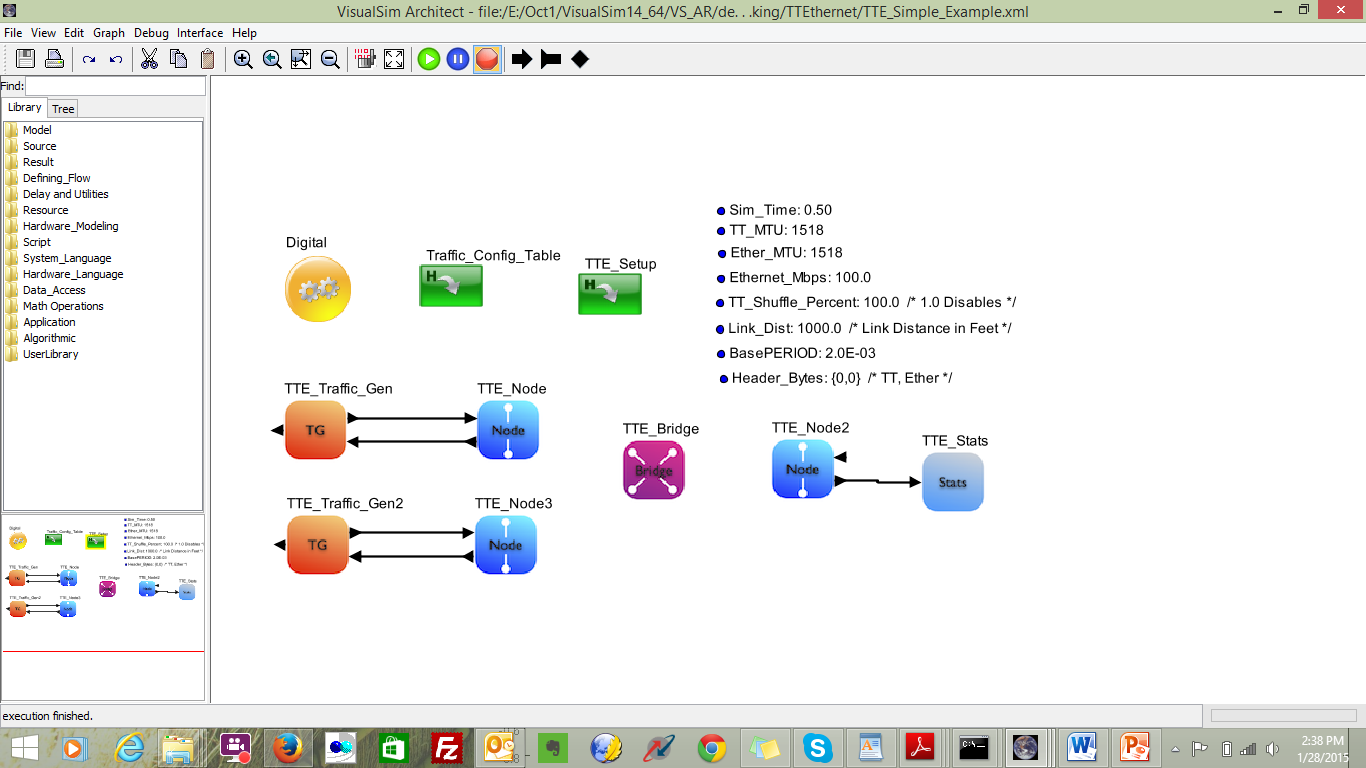
- All the Source and Destination node names must start with Node_ followed by a number
- All Bridges must start with Bridge_ followed by a number
- Each Traffic Generator will have a separate Traffic Table
- Bandwidth credit and Class type for all streams from all nodes are listed in a single Stream Table
- TTE_Setup block must be present in all models using TTEthernet libraries
- The TTE_Config_Table is only an example of the required Tables. The user must modify all the Tables to setup the required configuration. Additional Traffic Tables must be added to cover all the Nodes and need to make sure TT_Config_Table is configured correctly.
- Construction Steps
- TTE_Config_Table configuration
- Pre-Process block called TTE_Setup
- Instantiate Nodes and Bridges
- Add the traffic for each Nodes and define mode of message transmission.
- Attach Statistics block to each of the nodes that are receiving the data.
1. Drag Application->Networking->TTE->TTE_Config_Table into block diagram editor
This provides the list of sample Tables that are required for the TTEthernet model.
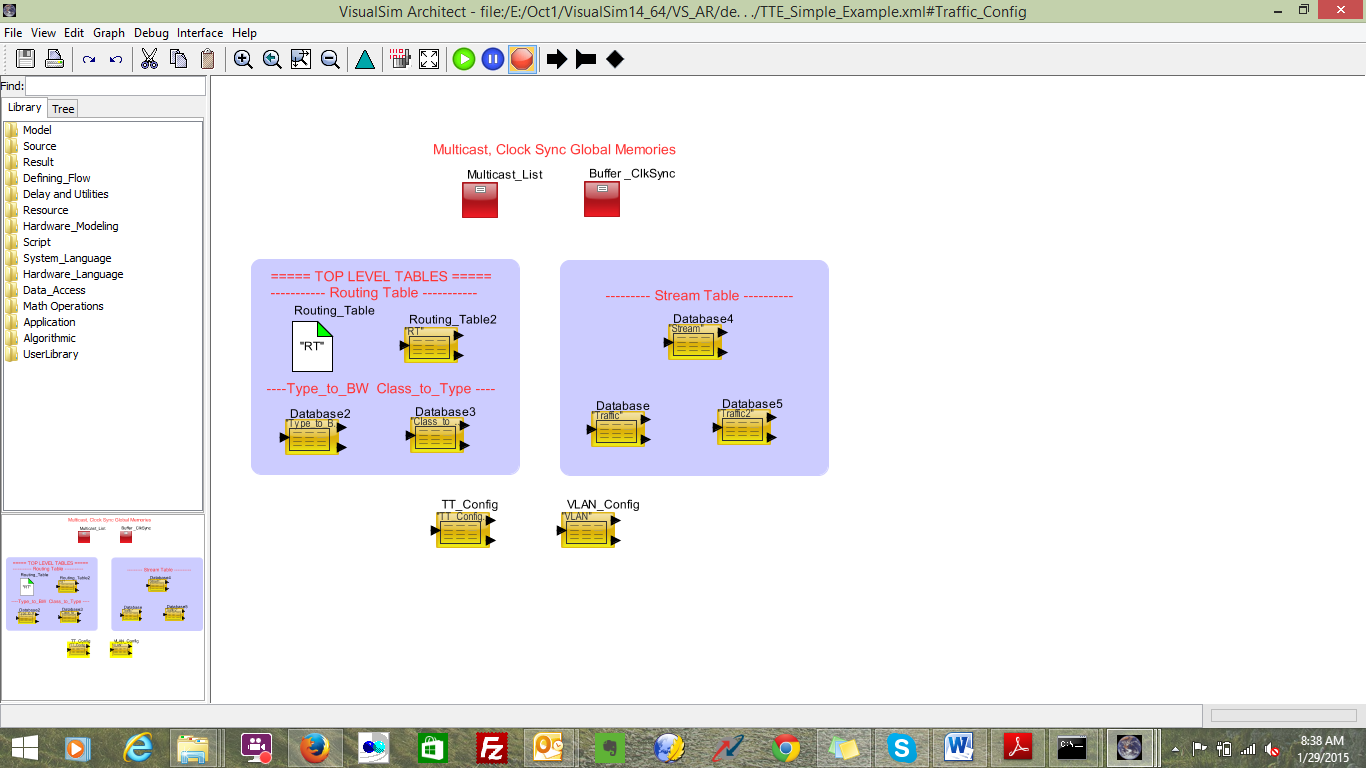
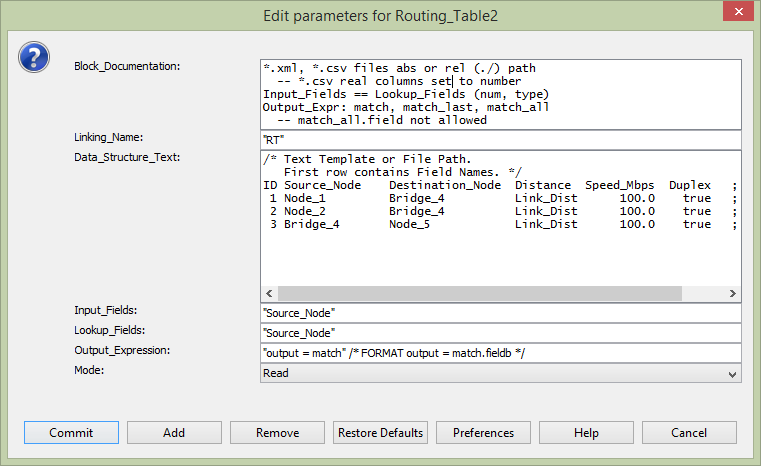
Percent_BW global 0.75 ; ---Maximum allocation to Class A or B of the total bandwidth for that Type
Default_ProcTime global 1.0E-06; Default Processing time for node processing.
Max_Buffer_Pkts global 256 ; Maximum buffer packet size.
Max_Pkt_Bytes global 1500 ; ---Maximum packet size Max_Buffer_Pkts global 256 Maximum number of buffers at each Node. Each buffer can hold one Data Structure or packet
Grand_Master global "Node_1" ; ---Node Name of the Master for the Clock Sync. Grand_Master_Rate global 200.0E-03 ; ---Rate of Clock Synchronization messages from the Grand Master Node
1.3 Multicast_List: Please make sure that you have required source and destination names in the table
1.4 Traffic Table: One table is required for each Node. Enter the list of TT, RC and Ethernet streams. One sample table is provided. Copy this instance to generate the required number of traffic tables. Make sure to give each Table a unique Name for the Linking_Table_Name. The list of all the Traffic_Tables must be provided to the TTE_Setup block.
ID Identifier Task_Source Task_Destination Mbps Task_Size Start_Time Stop_Time Protocol VLAN Type ;
1 "TT1" Node_1 Node_5 TT_Mbps TT_Bytes 3.0e-12 0.5 UDP 1 7 ;
2 "RC1" Node_1 Node_5 0.5 64 1.5E-03 0.5 UDP 2 6 ;
3 "RC2" Node_1 Node_5 0.5 128 2.0E-03 0.5 UDP 3 6 ;
4 "Ethernet" Node_1 Node_5 0.3 64 2.5E-03 0.5 UDP 4 5 ;
ID: Increasing sequence number
Identifier: This determines the message stream type
Task_Source: Name of this Source Node.
Task_Destination: Name of the final destination or listener.
Mbps: Generation rate of this traffic stream
Task_Size: Packet data size. Does not include headers or tailers
Start_Time: Time in seconds after the start of the simulation
Stop_Time: Time in seconds after the start of the simulation
Protocol: UDP or TCP
VLAN: This is VLAN ID and it enables users to select BAG
Type: Type of Class. Can be 0 to 7.
1.5 Stream: This table contains the Class and the requested bandwidth for all TTEthernet stream from all the nodes.
ID Mac_ID Identifier SR_Class Mbps ;
1 "a0:36:9f:0c:77:38" "TTE1" A 0.2 ;
2 "a0:36:9f:0c:77:38" "RC1" A 0.2 ;
3 "a0:36:9f:0c:77:38" "RC2" B 0.5 ;
4 "a0:36:9f:0c:77:38" "Ethernet" A 0.3 ;
5 "a0:36:9f:0c:77:39" "TTE2" A 0.2 ;
6 "a0:36:9f:0c:77:39" "RC3" A 0.2 ;
7 "a0:36:9f:0c:77:39" "RC4" B 0.5 ;
8 "a0:36:9f:0c:77:39" "Ethernet" A 0.3 ;
9 "a0:36:9f:0c:77:3A" "TTE3" A 0.2 ;
10 "a0:36:9f:0c:77:3A" "RC5" A 0.2 ;
11 "a0:36:9f:0c:77:3A" "RC6" B 0.5 ;
12 "a0:36:9f:0c:77:3A" "Ethernet" A 0.3 ;
ID: Increasing sequence number
MAC_ID: Physical address of the Node
Identifier: Unique ID for each TTE stream. This must match the Identifier in the Traffic Table.
SR_Class: Stream Reservation class of this TTE stream- A or B.
Mbps: Requested bandwidth
1.5 Type_to_BW: For each Bridge and Node in the model, the amount of bandwidth allocated to each Type is specified in this Table. Top Level parameter Bandwidth_Mbps determines Ethernet Speed and is common for all nodes.
Sample Format is as below
ID Type Node_1 Node_2 Node_3 Bridge_4 Bridge_5 Node_5 ;
0 0 0.0 0.0 0.0 0.0 0.0 0.0 ; /* Background */
1 1 0.0 0.0 0.0 0.0 0.0 0.0 ; /* Best Effort */
2 2 0.0 0.0 0.0 0.0 0.0 0.0 ; /* Excellent Effort */
3 3 1.0 1.0 1.0 1.0 1.0 1.0 ; /* Video 50ms latency */
4 4 1.0 1.0 1.0 1.0 1.0 1.0 ; /* Critical Apps */
5 5 25.0 25.0 25.0 33.0 33.0 33.0 ; /* Video 2ms latency */
6 6 25.0 25.0 25.0 25.0 25.0 25.0 ; /* Internet Control */
7 7 40.0 40.0 40.0 40.0 40.0 40.0 ; /* Network Control, highest */
ID: Increasing sequence number starting from 1.
Type: Type of Class. The values are 0 to 7
Node_1, Bridge_1...: Bandwidth allocation. The sum of all the rows of each column must not exceed the total bandwidth of the link.
Please make sure that you have included all the available nodes in the model
1.6 Class_to_Type- For each Bridge and Node in the model, the mapping of Type to Class and B.
Sample table is as shown below
ID Class Node_1 Node_2 Node_3 Bridge_4 Bridge_5 Node_5 ;
0 A 4 4 4 4 4 4 ; /* Background */
1 B 3 3 3 3 3 3 ; /* Best Effort */
ID: Increasing sequence number starting from 1
Class: A or B
Type: Type of Class. The values are 0 to 7. Common to all Nodes and Bridges in the model.
1.7 TT_Config_Table: TT_Config table provides the timing precision for Time-Triggered messages. StartTime is computed based on the task size and the Network Speed. User should enter details for the complete flow, for example if Source node is Node_1 and the destination is Node_5 then all the Nodes and bridges involved in communication flow should be defined in the table.
Sample TT_Config_Table is shown below
Node TTName StartTime BasePeriod ProcTime ;
"Node_1" "TT1" 1.25E-03 BasePERIOD ProcTIME ;
"Node_2" "TT1" 2.0E-03 BasePERIOD ProcTIME ;
"Node_3" "TT3" 3.0E-03 BasePERIOD ProcTIME ;
"Bridge_4" "TT1" 2.5E-03 BasePERIOD ProcTIME ;
"Bridge_4" "TT2" 3.0E-03 BasePERIOD ProcTIME ;
"Bridge_4" "TT3" 3.5E-03 BasePERIOD ProcTIME ;
"Bridge_5" "TT1" 3.0E-03 BasePERIOD ProcTIME ;
"Bridge_5" "TT2" 3.5E-03 BasePERIOD ProcTIME ;
"Bridge_5" "TT3" 4.0E-03 BasePERIOD ProcTIME ;
"Node_5" "TT1" 3.5E-03 BasePERIOD ProcTIME ;
1.8 VLAN: No change is required. In this table based on the VLAN ID BAG is allocated. For the Rate Constrained traffic stream this table decides the allocated bandwidth for a given VLAN. User can have as many VLAN’s and associated with BAG and LMax time. Sample VLAN table is shown below;
ID VLAN BAG LMax ;
1 1 1.0e-6 256 ;
2 2 1.5e-6 512 ;
3 3 2.0e-6 1024 ;
4 4 2.0e-6 1024 ;
5 5 2.0e-6 1024 ;
Step2
b. Link the Routing_Table_Name parameter to the top-level. This ensures that all blocks will use the same name.
c. In the parameter ‘Traffic_Tables’, list all the traffic tables names as strings in array.
Step3
Each transmitting node or synchronizing master node requires two blocks – TTE_Traffic_Gen and Node block. The assembly of the two blocks is as below
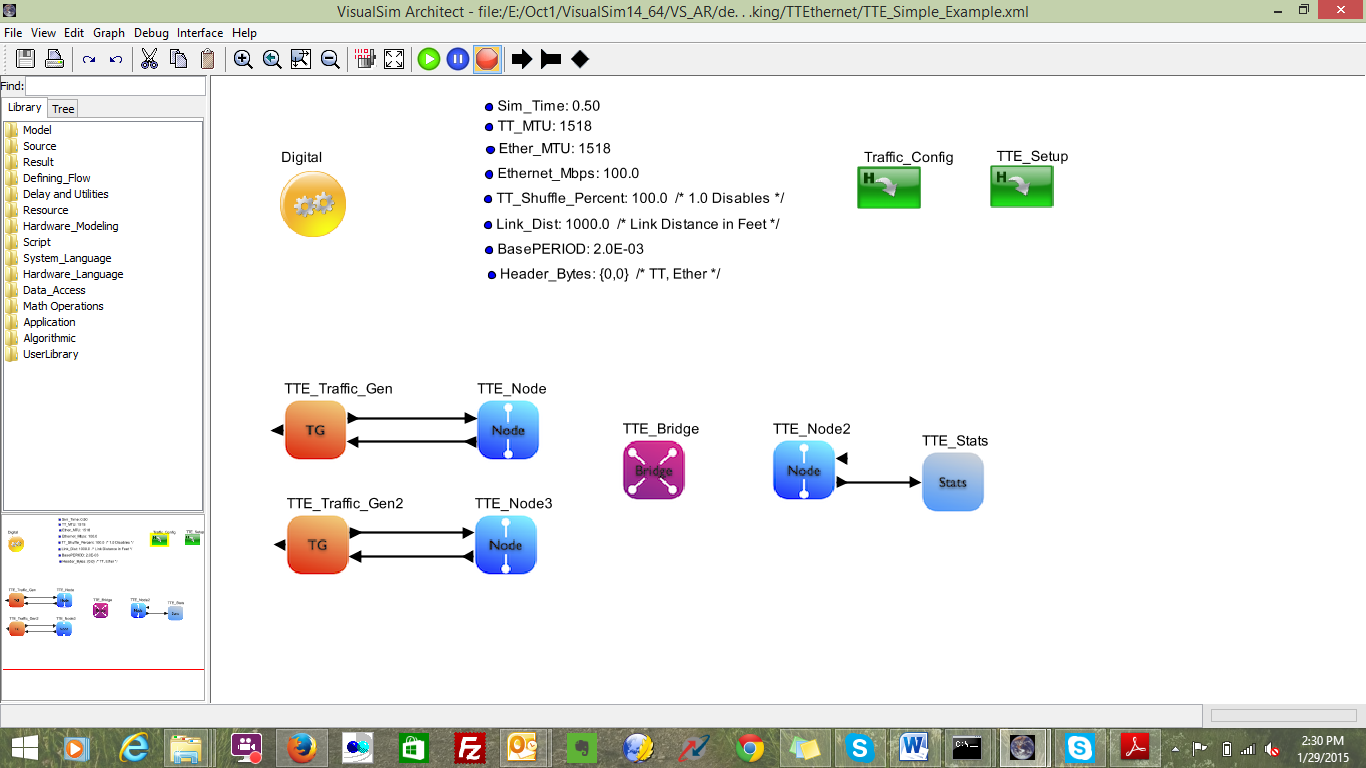
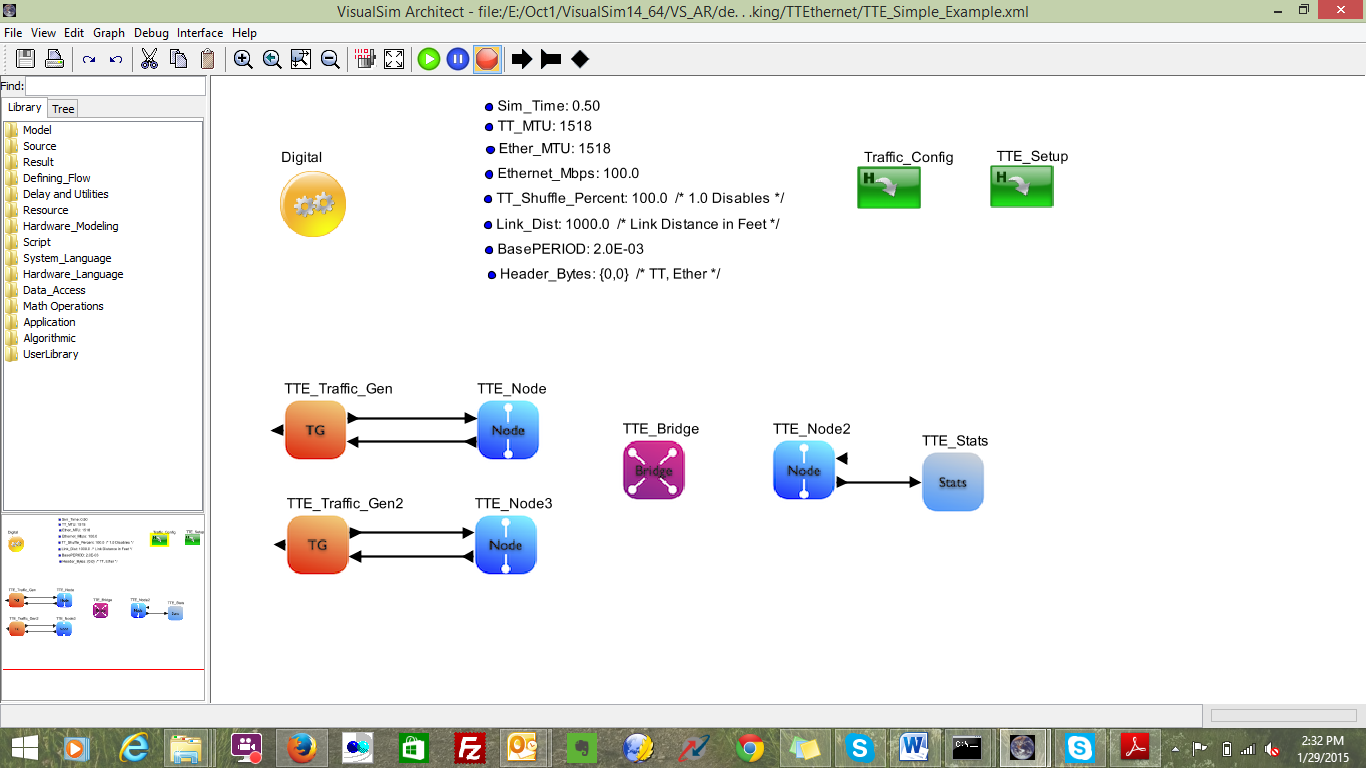
Step4
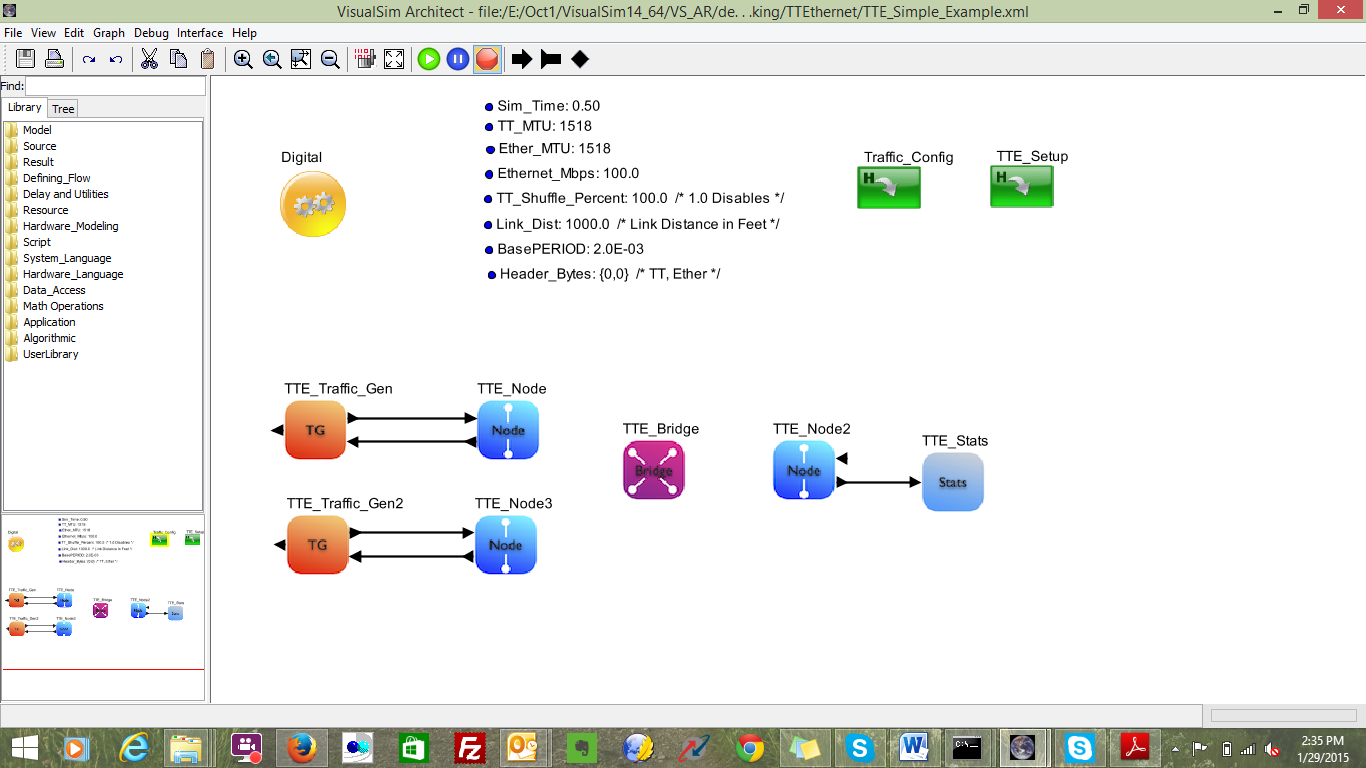
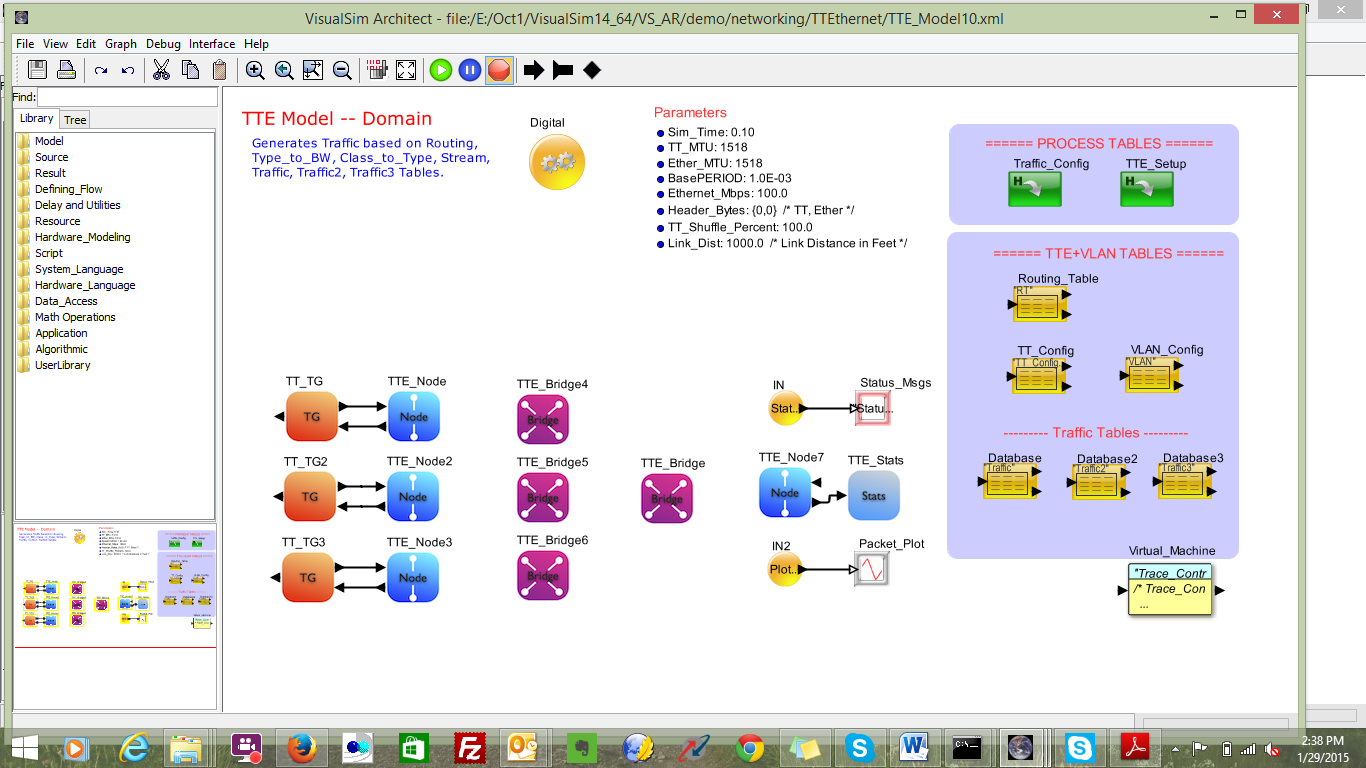
The following is the sequence:
a. Add as many Application->Networking->TTE->TTE_Bridge blocks as you have defined in the Link Configuration table
b. Assign a unique name to each Bridge block. The rule here is that the name must be Bridge_ followed by a number. No two Bridges can have the same
c. For the parameter, add the Routing_Table_Name. For now it is just “RT”.
Step5
The TTE_Stats block can be connected directly to the Node out for a Destination-only or the data_out port of the TT_Traffic_Gen block for a Source+Destination block.
The TTE_Stats generates 3different pieces of information. They are:
1. The latency statistics and through for all the streams arriving at Node to which this TTE_Stats is connected.
|
Time-Triggered |
Rate
Constraint |
|
N1_to_N5_TT1_1 Latency Minimum: 2.5061367090 ms Mean: 2.5061367090 ms Std Dev: 29.1 ps Maximum: 2.5061367090 ms Throughput Mbps: 0.0328661952051 |
N2_to_N5_RC2_3 Latency Minimum: 24.5134240 us Mean: 494.2624945 us Std Dev: 571.1953459 us Maximum: 2.0779767120 ms Throughput Mbps: 0.5011401721222 |
|
Ethernet |
|
|
N1_to_N5_Ether_4 Latency Minimum: 14.2734240 us Mean: 519.6828018 us Std Dev: 617.3499543 us Maximum: 2.8099000580 ms Throughput Mbps: 0.3010222764019 |
|
Here
N1_to_N5- Node_1 to Node_5
TT_1- Time Triggered stream with ID 1 in the Traffic Table
RC2_3- Rate Constrained stream with ID 3 in the Traffic Table
Ether_4- Ethernet stream with ID 4 in the Traffic Table
Minimum- Lowest latency recorded during the simulation
Maximum- Highest latency recorded during the simulation
Mean- Average of all the latencies recorded
Std Dev- Standard Deviation of the latencies
2. Graphical plot showing the Latency for all the streams arriving at the Node to which this TTE_Stats block is connected.
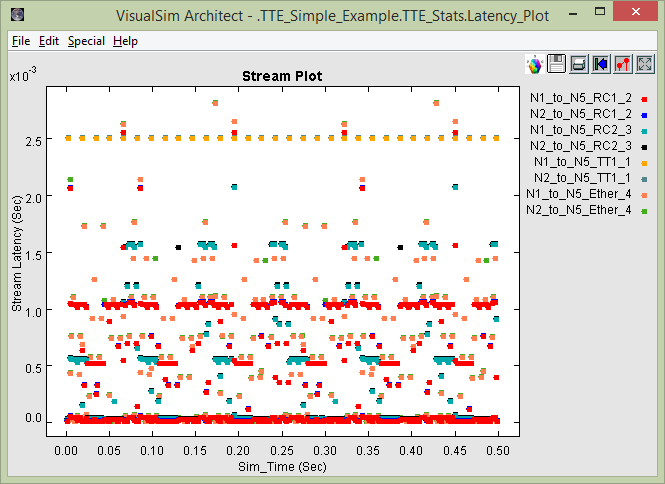
3. Histogram of the Latency for all the streams arriving at the Node to which this TTE_Stats block is connected.
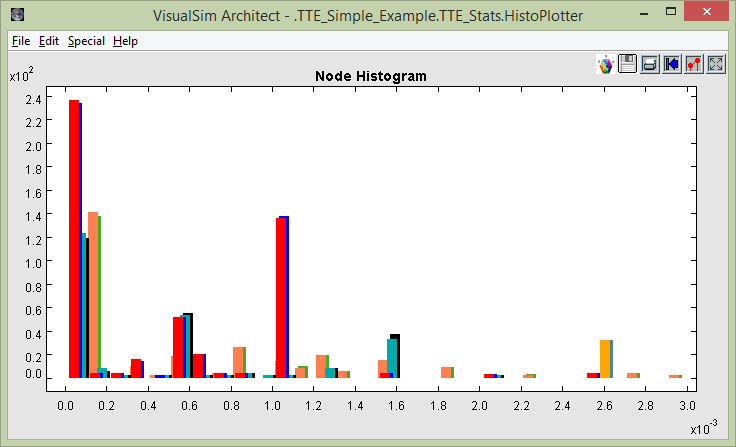
The following is the connection sequence:
b. Enter the name of the Node that this block is connected.
Step6
For each run, the statistics are provided in a combination of files and graphical plots. View Step 6 to see the list of plots and reports.
Advanced Tutorial
1.TTEthernet model with 8 Source Nodes
Let us make use of TTEthernet_Simple_Example.xml model to extend the system with additional 6 Nodes or total of 8 Nodes.
Step1:
Extending System with additional Nodes and configure TTE_Config_Table
- Instantiate additional TT_Node’s and provide unique name. Connect TT_Traffic_Gen blocks for each TT_Node’s and provide unique name.
- Open TT_Config_Table block, create additional Traffic_Table’s for all Source Nodes.
- Update Routing Table (RT) with additional node details
- Update additional node details to Type_to_BW and Class_to_Type blocks.
- Update TT_Config table with updated Traffic_Table details (TT1, TT2, TT3…) and timing precision based on the network speed and task size.
- VLAN Table – No modification is required
- Stream Table – No modifications required
TTE_Setup
1.Update Traffic_Tables parameter with all additional Traffic_Table’s names
Step3:
Run Simulation
2. TTEthernet Model with 8 nodes and 3 Destination Nodes
In this tutorial we shall extend the model developed in advanced tutorial part 1.
Step1:
Open the model developed in Part-1 and instantiate additional destination nodes and TTE_Stats blocks. Provide unique names for TTE destination nodes.
Step2:
Open TTE_Config_Table block and update Routing Table(RT), Type_to_BW, Class_to_Type, TT_Config and Traffic Table. With Regards to Traffic table, user can decide which is the Destination node should be selected.
Step3:
Run Simulation
Note: Final version of the model is available in VS_AR\doc\Training_Material\Tutorial\WebHelp\Tutorial\Networking\TTE_8_Nodes_3dest_Nodes.xml
3. TTEthernet Model with 8 Nodes, 2 Bridges and 3 Destination Nodes
In this tutorial we shall extend the model developed in advanced tutorial Part2.
Step1:
Open the model developed in Part-1 and instantiate additional 1 TTE_Bridge block. Provide unique name.
Step2:
1 Node_1 Bridge_4 Link_Dist 100.0 true ;
2 Node_2 Bridge_5 Link_Dist 100.0 true ;
3 Node_3 Bridge_4 Link_Dist 100.0 true ;
4 Node_4 Bridge_5 Link_Dist 100.0 true ;
5 Node_5 Bridge_4 Link_Dist 100.0 true ;
6 Node_6 Bridge_5 Link_Dist 100.0 true ;
7 Node_7 Bridge_4 Link_Dist 100.0 true ;
8 Node_8 Bridge_4 Link_Dist 100.0 true ;
9 Bridge_4 Node_10 Link_Dist 100.0 true ;
10 Bridge_5 Node_10 Link_Dist 100.0 true ;
11 Bridge_5 Node_11 Link_Dist 100.0 true ;
12 Bridge_4 Node_12 Link_Dist 100.0 true ;
Step3:
Run Simulation
Note: Final version of the model is available in VS_AR\doc\Training_Material\Tutorial\WebHelp\Tutorial\Networking\TTE_8_Nodes_3dest_Nodes_2Bridge.xml